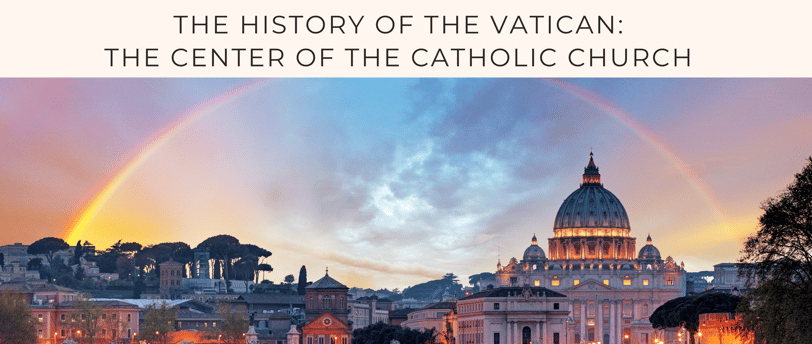The History of the Vatican: From Martyrdom to the Heart of the Church
Blog post description.
7/10/20253 min read


The Vatican is the spiritual and administrative center of the Catholic Church, a city-state that is the smallest in the world yet carries immense historical and spiritual significance. Pilgrims from every continent travel to this sacred place, not just to admire its beauty, but to encounter the living heart of the Church.
But how did the Vatican come to be, and why is it so important to Catholics?
The Beginnings: Peter’s Martyrdom
The Vatican’s story begins with Saint Peter, the leader of the Apostles, whom Jesus appointed as the visible head of His Church (Matthew 16:18). According to tradition, Peter was martyred in Rome during the persecution of Christians under Emperor Nero around 64 AD. He was crucified upside down near the Vatican Hill, as he did not feel worthy to die in the same manner as Christ.
Peter was buried in a nearby necropolis, and his grave quickly became a site of Christian veneration, even as persecution continued. Early Christians would gather near his tomb, risking their lives to celebrate the Eucharist and honor the first Bishop of Rome.
Constantine and the First Basilica
In the fourth century, after Emperor Constantine legalized Christianity with the Edict of Milan in 313 AD, he ordered the construction of a grand basilica over the site of Saint Peter’s tomb. Completed around 349 AD, the Old St. Peter’s Basilica became a major pilgrimage site, establishing the Vatican as a central place of worship.
This basilica stood for over 1,000 years, witnessing countless councils, papal elections, and historical moments in the Church.
The Renaissance and St. Peter’s Basilica
By the 15th century, the old basilica had fallen into disrepair. In 1506, Pope Julius II initiated the construction of a new St. Peter’s Basilica, which would become one of the greatest architectural feats in history. Renowned artists and architects, including Michelangelo, Bernini, and Bramante, contributed to its design.
The magnificent dome, designed by Michelangelo, became a symbol of the Church’s universality, rising above the tomb of Saint Peter and signifying the Church’s unbroken continuity.
St. Peter’s Basilica was consecrated in 1626 and remains the largest church in the world, a place where popes, pilgrims, and faithful gather to worship God and celebrate the sacraments.
The Vatican as a Sovereign State
For centuries, the popes ruled over the Papal States, a large territory in Italy. However, in 1870, Italian unification led to the capture of Rome, and the Pope’s temporal power was greatly reduced, leading to a period known as the “Roman Question.”
This dispute was resolved in 1929 with the Lateran Treaty, signed between the Holy See and Italy, establishing Vatican City State as an independent sovereign entity. Covering just 109 acres, Vatican City is the smallest country in the world, yet it is a vital spiritual center for over 1.3 billion Catholics.
The Vatican Today: A Living Heart
Today, the Vatican is more than a historical site. It is the administrative heart of the Catholic Church, housing the Holy See (the governing body of the Church) and the residence of the Pope, the successor of Saint Peter.
Vatican City includes:
St. Peter’s Basilica: The spiritual heart where pilgrims attend Mass and view the tomb of Saint Peter.
The Sistine Chapel: Home to Michelangelo’s masterpiece and the site of papal conclaves.
The Vatican Museums: Housing sacred art and historical artifacts that testify to centuries of faith.
The Apostolic Palace: The Pope’s residence and offices.
Why the Vatican Matters
For Catholics, the Vatican is not merely a place of history but a sign of the Church’s unity and apostolic mission. It is a place where the faith of the martyrs, the wisdom of the Fathers, and the prayer of the faithful converge.
Pilgrims come to the Vatican to:
Deepen their faith
Participate in Mass with the Pope
Witness the universality of the Church
Pray at the tomb of Saint Peter
It is a reminder that the Church is alive, rooted in history, yet always moving forward in the mission of Christ.
A Legacy of Faith
The Vatican, from the martyrdom of Saint Peter to the present, stands as a testament to God’s faithfulness and the Church’s mission to proclaim the Gospel to the world. It is a place where stone and Spirit meet, where pilgrims find strength, and where the Church continues to say, “You are Peter, and upon this rock I will build my Church.”
Whether you are planning a pilgrimage or seeking to understand your faith more deeply, learning about the Vatican helps you see your connection to the living Body of Christ that spans centuries and nations.
Faith
Sharing God's grace with joy and kindness.
Grace
© 2025. All rights reserved.
